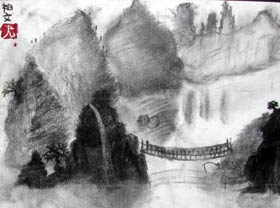Fun Experiments With Chinese Ink Paintings
You might imagine ink painting to be very difficult, because Chinese painting places too much emphasis on the power of strokes. You may be turned off because you feel you lack the ability to draw. In fact, times have changed; people’s way of life have changed dramatically. Of course, ideas, views and even the music we listen to are all different, so the image of painting will follow this change.
Oriental paintings can be said to have originated from Chinese paintings thousands of years ago, a process that has spawned great brilliant historical achievements. Compared to that of the rest of the world, Chinese artistic achievements were much more developed; art flourished in the Tang Dynasty, and after a thousand years, reached its peak during the Song Dynasty. Even before the dawn of the European Renaissance in the fifteenth and sixteenth-century, Chinese painting culture was already very all-encompassing and profound.
This is evidenced by the mature and powerful lines found in Figure 1, Tang dynasty painting "Polo”. But before the Tang Dynasty, painting a mountain meant only simple lines to draw crude shapes, required that lines be placed in similar fashion to calligraphy, and mandated holding a pen straight up to outline a subject with straight lines; obviously, following these rules, one cannot fully express a mountain. With all the shadows, concavities and convexities (small and large), bright and dark differences. there was no real way to show the overall sense of the mountain, or rough texture of the rocks.
Figure 1.
Crown Prince Zhanghuai, (653 - 654, Tang Dynasty)
Polo
Fence Mural
After the Song dynasty the methods changed; artists were finally allowed to use the brush tilted, for a thick line, and almost horizontally, for even thicker. They were allowed to freely express casted shadows, and different lines, textures, lights, and shades, resulting in the popularity of landscape paintings. At that time, painters were very careful in thoroughly observing nature, and from observing scenes of nature, accumulated experience. So eventually, this period formed the most unique Chinese ink paintings, and had a massive impact on the "crack technique" (皴法: Cūnfǎ). Figure 2, "Seclusion Picture," is a wonderful example of landscape painting.
"Crack" in the dictionary is wrinkled or chapped. Chinese “crack” (皴:Cūn) is a method of drawing lines to draw rocks, mountains and bark. As more and more painters made their own observations, they created their own inventions and expressions of scenic landscape painting; unfortunately, over the development of thousands of years, leaders in art communities set more rules and became more strict again. Their guidelines and methods slowly formed into a specific formula, with very strict rules and constraints. There were many different schools of thought, but to deviate from them was not allowed. The many different ways to draw the pattern of bark include: pine bark like fish scales, cypress bark with a rope texture, sycamore bark drawn using horizontal lines. Even rock-drawing techniques varied between the north of south of China.
Figure 2.
Fu Wang (1362 - 1416, early Ming Dynasty)
Seclusion Picture
Ink on Paper, 70.7 x 41.7 cm
The Palace Museum, Beijing
Within the past two or three hundred years, it has not been easy to break through the long history of the rules of the painting. lnk painting has been in decline and has no longer been leading to innovation and breakthrough. People no longer cared for it, so less people created ink paintings and less people knew how to appreciate it. Fortunately, many people now think that we should abolish these rules, and try to find a breakthrough for the Chinese painting method. So, many artists are beginning to use their own methods to explore and experiment, with the purpose of finding a new method of expressing Chinese ink painting.
In fact, the most unique aspect of Chinese ink painting is "artistic conception.” The beauty of this conception is the idea that perhaps you aren’t limited to using only brush and/or xuan paper. Figure 3 is the new taste of modern painters attempting to use different materials to draw based on and achieve the same ink painting conception.
Figure 3.
Jing Zhong
Mountain by the Sea, 2003
43 x 58 cm
Children obviously wouldn’t know the rules of drawing restrictions, so they are able to join the side that supports for modern "experimentation.” They may find new possibilities for ink painting. Figure 4 is an interesting painting a child did with charcoal. You can also join the new method of experimenting with ink painting.
Figure 4.
BoWen You (11 years old)
Landscape



